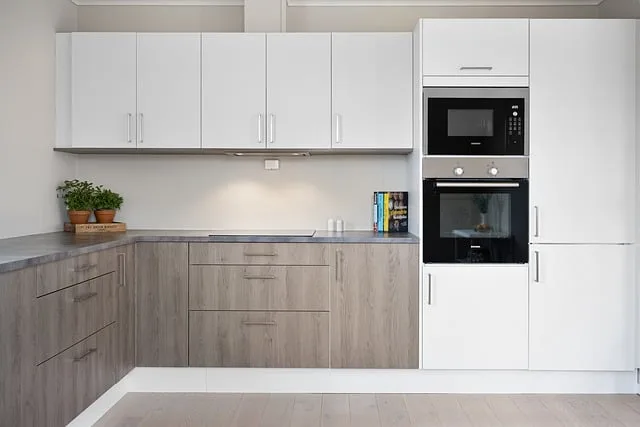First things first, grab a tape measure and a notepad. You’ll want to measure the width, height, and depth of the space where your cabinets will go. Start from the floor to the ceiling for height, and don’t forget to account for any crown molding or trim at the top. For width, measure from one wall to the other, and for depth, check how far out you want your cabinets to extend. It’s like finding the right size of a puzzle piece; you want it to fit snugly without any awkward gaps.
Now, here’s a pro tip: always measure in three places—top, middle, and bottom. Walls can be a bit like that friend who can’t decide on a favorite movie; they might not be perfectly straight! By measuring at different heights, you’ll get a more accurate picture of your space.
Also, keep an eye out for any obstacles like windows, doors, or electrical outlets. These can affect your cabinet layout, so note their locations. Think of it as navigating a maze; you want to avoid any dead ends!
The Ultimate Guide: Mastering the Art of Measuring for Kitchen Cabinets
First things first, grab a trusty tape measure. You’ll want to measure the width, height, and depth of the space where your cabinets will go. Think of it as taking the vital statistics of your kitchen. Start from the floor to the ceiling for height, and don’t forget to account for any appliances or fixtures that might get in the way. It’s like playing a game of Tetris—every piece needs to fit just right!

Next, measure the wall space where your cabinets will hang. This is where things can get a bit tricky. Walls aren’t always perfectly straight, so be sure to check for any bumps or dips. You wouldn’t want your cabinets to look like they’re doing the limbo, would you?
Also, consider the layout of your kitchen. Are you going for a U-shape, L-shape, or maybe a galley style? Each layout has its quirks, and understanding these will help you visualize how your cabinets will flow in the space.
Lastly, don’t forget about the height of your countertops. You want your cabinets to complement them, not clash. Think of it as creating a harmonious relationship between your cabinets and countertops—like peanut butter and jelly!
So, roll up your sleeves, grab that tape measure, and let’s get to work on making your kitchen dreams a reality!
Avoid Costly Mistakes: Essential Tips for Accurate Kitchen Cabinet Measurements
First off, grab a trusty tape measure. It’s your best friend in this process. Start by measuring the height, width, and depth of the area where your cabinets will go. But don’t just stop there! Check for any irregularities in the walls or floors. You wouldn’t want to install cabinets only to discover they’re leaning like the Tower of Pisa, right?
Next, consider the layout. Are you going for a U-shape, L-shape, or something more unique? Sketch it out! Visualizing your space can help you see where cabinets will fit best. And don’t forget about the space between cabinets and appliances. You want to ensure there’s enough room for doors to swing open without playing a game of Tetris.
Also, think about the height of your cabinets. If you’re tall, you might want them higher up, but if you’re on the shorter side, lower cabinets could save you from a daily workout. And let’s not forget about the crown molding! Measure the height of your ceiling to ensure your cabinets don’t end up looking like they’re wearing a hat that’s too small.
Lastly, always double-check your measurements. It’s like the old saying goes: “Measure twice, cut once.” Taking that extra moment can save you from a world of headaches and expenses. So, roll up your sleeves, grab that tape measure, and let’s get those kitchen cabinets fitting like a glove!
From Blueprint to Reality: How to Measure Your Space for Perfect Kitchen Cabinets
First off, grab a trusty tape measure. You’ll want to measure the width, height, and depth of the area where your cabinets will go. Start from the floor to the ceiling—this gives you a clear idea of how tall your cabinets can be. Don’t forget to measure the width of each wall. It’s like taking the pulse of your kitchen; you need to know how much room you have to work with.
Now, here’s a pro tip: always measure in multiple spots. Walls can be a bit like that friend who can’t make up their mind—sometimes they’re straight, and other times they’re not. By measuring at different points, you’ll get a more accurate picture of your space.
Next, consider any obstacles like windows, doors, or electrical outlets. These are the quirks of your kitchen that can throw a wrench in your plans. Make sure to note their locations and dimensions. Think of it as navigating a maze; you want to avoid any dead ends.
Lastly, jot everything down. Create a simple sketch of your kitchen layout, marking where each measurement falls. This visual guide will be your best friend when it’s time to choose your cabinets. Remember, the goal is to create a harmonious flow in your kitchen, where every cabinet feels like it belongs. So, roll up your sleeves, measure with care, and watch your dream kitchen come to life!
Unlocking the Secrets: A Step-by-Step Approach to Measuring for Kitchen Cabinets
First things first, grab a trusty tape measure. You wouldn’t go on a road trip without a map, right? Start by measuring the width, height, and depth of your space. Don’t just eyeball it; precision is key! Measure from the floor to the ceiling, and don’t forget to check for any obstacles like windows or electrical outlets. Think of it as mapping out your territory.
Next, it’s time to measure the existing cabinets, if you have any. This is like checking the score before the big game. You want to know what you’re working with. Measure the height from the floor to the bottom of the upper cabinets and the space between them and the countertop. This will help you visualize how new cabinets will fit into the mix.
Now, let’s talk about the layout. Picture your kitchen as a stage, and the cabinets are the actors. You want them to shine! Sketch out your kitchen’s layout, marking where each cabinet will go. This will help you see how everything flows together.
Transform Your Kitchen: Expert Advice on Measuring for Custom Cabinets

So, how do you measure like a pro? Start by grabbing a tape measure and a notepad. Measure the width, height, and depth of your existing cabinets, if you have them. But don’t stop there! You’ll also want to measure the space between your countertops and the ceiling. This is crucial because it helps you determine how tall your new cabinets can be. Think of it as finding the perfect outfit; you wouldn’t want to buy a shirt that’s too long or too short, right?
Next, consider the layout of your kitchen. Are there any awkward corners or protruding appliances? Make note of these quirks, as they can affect how your cabinets fit. It’s like trying to fit a square peg in a round hole—frustrating and often impossible!
Also, don’t forget to measure doorways and hallways. You want to ensure your beautiful new cabinets can actually make it into your kitchen without a hitch. Picture this: you’ve ordered the cabinets of your dreams, only to find out they can’t fit through the door. Total bummer!
Frequently Asked Questions
What Are the Common Mistakes in Measuring for Cabinets?
Common mistakes in cabinet measurement include not accounting for the full height, width, and depth of the space, failing to measure around obstacles like pipes or outlets, and neglecting to consider the door swing and clearance. Additionally, using inaccurate tools or not double-checking measurements can lead to errors. Always measure twice and ensure all dimensions are precise to avoid costly mistakes.
How Do I Measure My Kitchen for Cabinets?
To measure your kitchen for cabinets, start by clearing the area and gathering tools like a tape measure and a notepad. Measure the width and height of each wall where cabinets will be installed, noting any windows, doors, or obstacles. For base cabinets, measure from the floor to the desired height, typically 34.5 inches. For wall cabinets, measure from the floor to the bottom of the cabinet, usually 18 inches above the countertop. Record all measurements accurately to ensure a proper fit.
How to Measure Cabinet Height and Width?
To accurately measure cabinet height and width, use a tape measure. For height, measure from the floor to the top of the cabinet. For width, measure across the front of the cabinet from one side to the other. Ensure to measure at the widest points and record the dimensions for precise fitting.
What Tools Do I Need to Measure for Kitchen Cabinets?
To accurately measure for kitchen cabinets, you will need a tape measure, a level, a pencil, and a notepad. The tape measure helps you determine the dimensions of the space, while the level ensures that surfaces are even. Use the pencil to mark measurements, and the notepad to record your findings for reference during the installation process.
How to Measure for Corner Cabinets?
To accurately measure for corner cabinets, start by determining the corner’s angle, typically 90 degrees. Measure the distance from the corner to the adjacent walls at both sides. Note the height from the floor to the desired cabinet top. Ensure to account for any obstructions like outlets or pipes. Finally, check for any irregularities in the wall to ensure a proper fit.